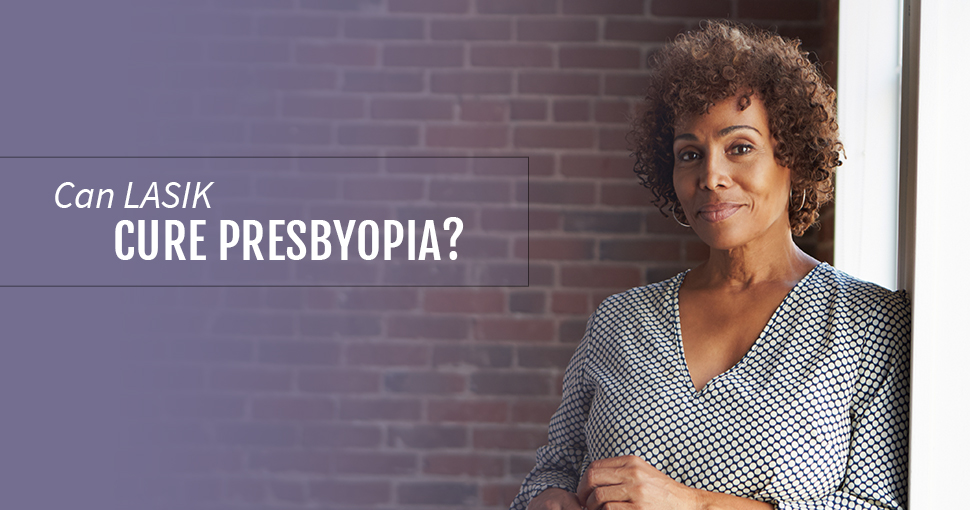Does LASIK Cure Presbyopia?

LASIK is a popular vision correction surgery that can improve eyesight for people with certain refractive errors, such as nearsightedness. If you are looking for a solution that can help you ditch reading glasses, it makes sense to think of LASIK. But can LASIK actually correct presbyopia?
Understanding Age-Related Near Vision Loss
As we age, the eye’s lens begins to stiffen and change shape, a natural process that gradually causes a type of near vision loss called presbyopia

Can LASIK Eliminate My Need for Reading Glasses?
LASIK can be a good option for people who are seeking treatment for nearsightedness or other typical refractive errors. However, it is not intended to treat presbyopia. LASIK works by reshaping the cornea, but the loss of near vision from presbyopia is a result of changes in the eye’s lens. Even if a LASIK procedure in your 20’s gave you freedom from glasses and contacts, you may still need reading glasses in your 40’s or 50’s.
Some eye doctors offer a treatment called monovision LASIK to treat presbyopia. In a monovision procedure, one eye is corrected for distance and the other for near vision. Monovision depends on the brain’s ability to adapt to it, so it does not work for everyone. After 40, many patients also have dry eye concerns and LASIK has been shown to cause increased dry eye symptoms.
Treatment Options for Presbyopia
Reading glasses are the most common way to correct presbyopia. However, many people don’t like the way they look in reading glasses or they are annoyed by the hassle of taking readers on and off throughout the day.
Refractive Lens Exchange (RLE)
One vision correction procedure that is sometimes used to treat presbyopia is called refractive lens exchange or RLE. Using methods that are essentially the same as cataract surgery, RLE involves replacing the eye’s natural lens with an artificial intraocular lens implant (IOL). Some types of premium IOLs, such as multifocal or trifocal lenses, can improve presbyopia and reduce the need for reading glasses. While IOLs are approved by the FDA as a medical device to treat cataracts, they are not intended to correct presbyopia as a primary function. There is limited data available since RLE is an off-label use of IOLs, but some experts have concerns about postoperative side effects that range from visual disturbances like halos and glare to more serious complications like retinal detachment.
There is currently no surgical option that is FDA-approved with an indication to treat presbyopia, but that doesn’t mean that you are limited to glasses as your only option—Learn more about potential treatments for presbyopia.
Have More Questions About Presbyopia?
We know that age-related vision changes can be frustrating and confusing, but the team at Presbyopia Life is here for you. Our vision experts provide educational resources to help you better understand presbyopia and empower you to take great care of your vision. Learn more:
- Do I Need Reading Glasses?
- Myths and Facts About Presbyopia
- Top 10 Presbyopia Questions Answered by Our Experts
- Is Presbyopia Affecting Your Day to Day Life?






1 American Optometric Association. Presbyopia. Available: https://www.aoa.org/healthy-eyes/eye-and-vision-conditions/presbyopia?sso=y Accessed September 9, 2020.
2 U.S. Food and Drug Administration. LASIK. Available: https://www.fda.gov/medical-devices/surgery-devices/lasik Accessed September 9, 2020.
3 Levitt AE, Galor A, Weiss JS, et al. Chronic dry eye symptoms after LASIK: parallels and lessons to be learned from other persistent post-operative pain disorders. Mol Pain. 2015;11:21. Published 2015 Apr 21. doi:10.1186/s12990-015-0020-7
4 Dhaliwal, Deepinder. Updates and Challenges in Refractive Lens Exchange. US Ophthalmic Review. January, 2018. DOI: 10.17925/USOR.2018.11.1.17




